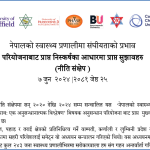
“As reported by National Policing Improving Agency, the most frequently encountered evidence at the scenes of a crime is footwear impressions and marks. Unfortunately, recovery and usage of this kind of evidence has not achieved its full potential. Due to the cost benefit ratio (time consuming casting procedures, expensive scanners) footprints are often neglected evidence. As technology changes, the capabilities of forensic science should continue to evolve. By translating academic research and technical ‘know-how’ into software (www.digtrace.co.uk) the authors have placed 3D imaging of footwear evidence in the hands of every police force in the UK and overseas.”
This was the abstract submitted to accompany Dominika’s recent submission to the Research Photography Competition.
 Tracks in the sand: tracking criminals
Tracks in the sand: tracking criminals










 New Nepal scoping review on maternal & neonatal health
New Nepal scoping review on maternal & neonatal health Fourth INRC Symposium: From Clinical Applications to Neuro-Inspired Computation
Fourth INRC Symposium: From Clinical Applications to Neuro-Inspired Computation Writing policy briefs
Writing policy briefs Upholding Excellence: The Concordat to Support Research Integrity
Upholding Excellence: The Concordat to Support Research Integrity ECR Funding Open Call: Research Culture & Community Grant – Application Deadline Friday 12 December
ECR Funding Open Call: Research Culture & Community Grant – Application Deadline Friday 12 December MSCA Postdoctoral Fellowships 2025 Call
MSCA Postdoctoral Fellowships 2025 Call ERC Advanced Grant 2025 Webinar
ERC Advanced Grant 2025 Webinar Horizon Europe Work Programme 2025 Published
Horizon Europe Work Programme 2025 Published Horizon Europe 2025 Work Programme pre-Published
Horizon Europe 2025 Work Programme pre-Published Update on UKRO services
Update on UKRO services European research project exploring use of ‘virtual twins’ to better manage metabolic associated fatty liver disease
European research project exploring use of ‘virtual twins’ to better manage metabolic associated fatty liver disease